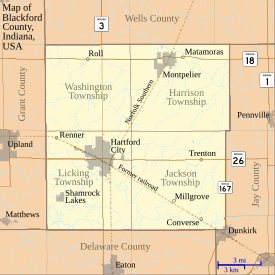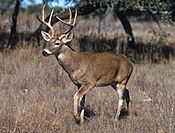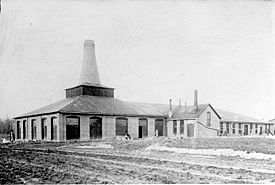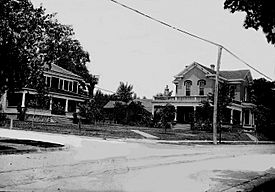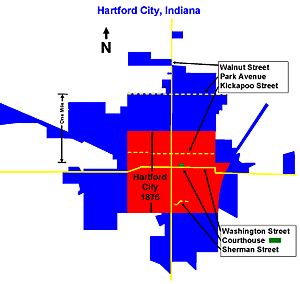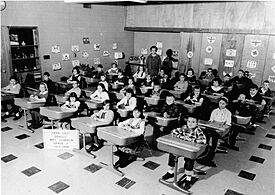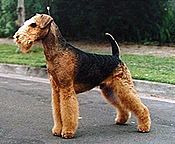History of Hartford City, Indiana facts for kids
Quick facts for kids
Hartford City, Indiana
|
|
|---|---|
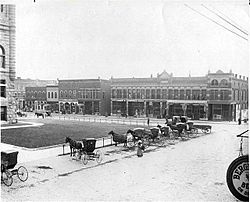
Hartford City courthouse square in 1908
|
|

Location in the state of Indiana
|
|
| Country | United States |
| State | Indiana |
| County | Blackford |
| Officially named | 1839 |
| Incorporated (town) | 1857 |
| Incorporated (city) | 1894 |
| Website | (Historical Society) http://www.bchs-in.org/ |
Hartford City, Indiana started in the late 1830s. It was just a few log cabins near a creek. This small community became the main town, or county seat, for Blackford County. Hartford City is in the north-central part of Indiana.
A big change happened in the late 1880s. People found natural gas nearby. This led to a 15-year "boom" for the town. Hartford City changed from a farming town to one with many factories. In the 1890s, it had the country's largest window glass company. It also had the biggest maker of lantern globes.
After the gas boom ended, the city kept many of its workers. Some glass factories and paper mills stayed open. New jobs in the car industry also appeared in nearby cities. In the first half of the 1900s, Hartford City attracted more factories. These included Overhead Door and 3M. The town's population went down in the 1970s and 1980s. This was partly because the car industry struggled. Also, the Overhead Door plant cut jobs and then closed.
Today, the Hartford City Courthouse Square Historic District is a special place. The National Park Service added it to the National Register of Historic Places in 2006. This means its buildings are important to history and architecture. Other important buildings are the Blackford County Courthouse and the First Presbyterian Church.
Contents
Early Days of Hartford City
Native American History
In the early 1800s, Native American tribes often visited the area. This was before Hartford City was built. No permanent settlements were known right where the town is now. Three tribes likely visited: the Miami, Delaware, and Potawatomi. Another tribe, the Kickapoo, might have lived there earlier. Hartford City even has a Kickapoo Street named after them.
A group of Delaware Indians lived about 19 miles south of Hartford City. They were along the White River. Later, the county to the south was named Delaware County after them. The city of Muncie got its name from their Munsee clan.
The Miami tribe was very strong in this region. Little Turtle (pictured) was a famous Miami warrior. He died in 1812. After Indiana became a state, Francois Godfroy led the Miami Indians in this area. He lived in what became northern Blackford County. The Miami and Delaware Indians were the first settlers of Blackford County. They lived on the Godfroy Reserve after a treaty in 1818. This reserve was about 9 miles from where Hartford City would be.
The Potawatomi tribe was supposed to stay north of the Wabash River. This river is about 30 miles north of Hartford City. But around 1830, some Potawatomi visited the area too often. Miami warriors fought them near Upland, Indiana, about 8 miles from Hartford City. This fight used knives and clubs, but no one died. The Potawatomi then went back to their lands.
First Settlers Arrive
The Indiana Territory was created in 1800. Indiana became a state in 1816. In 1831, Benjamin Reasoner was the first known non-native to visit Blackford County. He came back in 1832 with his family. They settled in what became Licking Township. His granddaughter, also named Mary, was the first non-native born in the county.
More settlers arrived in the 1830s. These included Andrew Boggs and John Grimes. John Grimes built the county's first water-powered mill. Jay County was created in 1835. A part of it later became Blackford County. The state created Blackford County in 1837. But it wasn't fully organized until 1839. The county is named after Judge Isaac Newton Blackford. He was a state Supreme Court judge. Hartford City is in Licking Township. As more settlers came, the Godfroy Reservation tribe moved west around 1839.
How Hartford City Got Its Name
Hartford City was first called Hartford. The spot for Blackford County's main town was chosen in 1837. This was before the town had an official name. People in nearby Montpelier didn't like this choice. But they couldn't change it. Licking Township, where Hartford City is, had more people. Also, some land was given for public buildings. This might have helped the decision. The county was organized in 1839, and the village was officially named Hartford. It was in the southwest part of today's Hartford City, near Lick Creek. Settlers found deer and wolves, but no Native Americans nearby.
A local story says Hartford was a place to cross Lick Creek. It was called "Hart’s ford" or "Hart ford." "Hart" might have come from a farmer named Jacob Hart. Or it could be an old English word for a male deer, a "hart." This name became Hartford. Since there was another Hartford in Indiana, the name was changed to Hartford City. This helped avoid confusion.
By 1842, Hartford had seven families in log cabins. They included the Branson, Brough, and Graham families. The Paytons and Graham were merchants. John Marley was the first blacksmith. Hartford grew to 250 people by 1850. It had about 40 houses. The town got a post office. A national directory in 1855 listed it as Hartford City. It officially became a town in 1857.
Getting Around: Early Transportation
When Indiana became a state, rivers were the best way to travel. Towns needed to be on a river. State planners thought canals could connect rivers. But by the late 1840s, they saw that railroads would be more important. Railroads grew very fast in Indiana. In 1850, there were only 200 miles of track. By 1860, there were over 2,000 miles. By 1873, over 3,700 miles were in use.
Blackford County's first planned railroad was the Fort Wayne & Southern Company. It was supposed to go from Fort Wayne through Hartford City to Muncie. Construction started in 1853. This line reached Hartford City in 1869. The first train from Fort Wayne to Muncie ran in 1870. This railroad changed names many times.
The second railroad to reach Hartford City was the Pittsburgh, Cincinnati & Saint Louis. It was finished in 1867. This line later became part of the Pennsylvania Railroad. After 1870, Hartford City had two railroad lines. One went north-south, and the other went east-west. The north-south line is still used today. The east-west line is not.
By the 1880s, Hartford City also had gravel roads. One gravel road went north-south through the whole county. Another went east-west through town. In the mid-1890s, the town had many paved streets. These were made from cedar blocks. In 1896, work began on Hartford City's first brick street.
The Gas Boom and Growth
A Town Transformed by Natural Gas
In the early 1880s, Hartford City had about 1,800 people. It had three churches, a school, two hotels, a bank, and newspapers. Factories made things like bricks and flour. Railroads connected the town to bigger cities. Good gravel roads also helped with travel.
In the late 1880s, people found natural gas in east-central Indiana. This started a "gas boom." Some oil was also found. Hartford City was in this gas area. The town could offer free or cheap natural gas to factories. This, plus good transportation, made it a great place for businesses. Jesse H. Dowell started the Hartford City National Gas and Oil Company. They drilled the city's first gas well in 1887.
By 1894, the Gas Boom helped the town build a new courthouse. It also got its own public water supply. By 1895, Hartford City had 10 natural gas companies. The town was booming! An 1895 directory listed 24 saloons and 13 law firms.
Many factories moved to the "Gas Belt" area. They were promised free gas and great transportation. Some companies that started in Hartford City during the boom were:
- Hartford City Glass Company
- Sneath Glass Company
- Hartford City Paper Company
- Utility Paper Company
- Congress Cycle Company (bikes)
- Willman Lumber Company
- A.A. Bowman & Company (buggies)
The Hartford City Glass Company was bought by American Window Glass Company. Hartford City's population grew from 1,470 in 1880 to 5,912 in 1900. In 1901, state inspectors visited 15 factories in Hartford City. These factories employed 1,077 people. This was a huge jump from 171 manufacturing jobs in 1880. American Window Glass Company was the biggest employer. Sneath Glass Company was second. Other glass factories, lumber, and tile companies also hired many people.
The gas boom changed east-central Indiana. It went from mostly farming to also having many factories. The populations of Blackford, Delaware, and Grant counties all doubled between 1880 and 1900. Hartford City became even more connected to bigger cities like Indianapolis. This was thanks to the interurban rail line. It started running in 1905 on Jefferson Street.
By 1905, the gas boom was mostly over. Much of the natural gas was wasted. But Hartford City was changed forever. Manufacturing became important, along with agriculture. The town had skilled workers. It had grown enough to become a city. The city's success meant it had good infrastructure. This included a water works, two railroads, the interurban system, and brick roads. Many buildings from that time are still used today. These include the courthouse, library, and some churches.
New technology also came to town. In 1895, there were two telephone companies and a telegraph company. Hartford City had at least one automobile by 1900. Mr. Ed Cooley bought an electric runabout. It could go 30 miles on one charge. In 1908, talking pictures were shown for the first time at the Star Theatre.
Life After the Gas Boom
| Historical population | |||
|---|---|---|---|
| Census | Pop. | %± | |
| 1850 | 250 | — | |
| 1860 | 618 | 147.2% | |
| 1870 | 878 | 42.1% | |
| 1880 | 1,470 | 67.4% | |
| 1890 | 2,287 | 55.6% | |
| 1900 | 5,912 | 158.5% | |
| 1910 | 6,187 | 4.7% | |
| 1920 | 6,183 | −0.1% | |
| 1930 | 6,613 | 7.0% | |
| 1940 | 6,946 | 5.0% | |
| 1950 | 7,253 | 4.4% | |
| 1960 | 8,053 | 11.0% | |
| 1970 | 8,207 | 1.9% | |
| 1980 | 7,622 | −7.1% | |
| 1990 | 6,960 | −8.7% | |
| 2000 | 6,928 | −0.5% | |
| 2010 | 6,220 | −10.2% | |
| 2020 | 6,086 | −2.2% | |
After the gas boom, some towns became ghost towns. But most factories in Hartford City stayed. There wasn't another gas boom elsewhere. Many skilled workers stayed in town. American Window Glass and Sneath Glass kept operating. The American Window Glass plant closed during the Great Depression. Its way of making glass became old-fashioned. Sneath Glass lasted until the 1950s. New plastics made many of its products unnecessary. Willman Lumber, another boom-era company, was still open in the 1970s. Hartford City's population stayed steady, even as the county's went down. Some workers found jobs in nearby cities. These included Muncie, Marion, and Anderson. These cities had jobs in the new car industry.
In the 1920s, city leaders convinced Overhead Door Company to move to Hartford City. It became a big employer for 40 years. Other companies like Hartford City Paper and Fort Wayne Corrugated Paper Company also had plants in town. By the 1930s, major businesses included Hartford Ice Company, Overhead Door, glass factories, and paper mills.
George D. Stevens: A Surprising Story
George D. Stevens was an executive at Fort Wayne Corrugated Paper Company. He moved to Hartford City in 1911. He was a quiet, well-dressed man who lived alone. He was good with machines and became an engineering executive. Stevens became one of the richest men in town. He was driven to and from work. He got a patent in 1931, which might have added to his wealth.
Stevens was known for his generosity in the community. He also started a foundation in his hometown of Akron, Ohio. He was a leading citizen and joined local clubs. He often sat in the hotel lobby and chatted with people. He died in Hartford City in 1940 at age 80. His death was big news. The paper mill even closed for half a day.
Some Hartford City citizens went to his funeral in Akron. They were surprised to learn that Stevens was a black man who had been living as a white man in an all-white town. This was during a time when some groups caused problems for black people in Hartford City. Perhaps Stevens felt he needed to hide his identity. Regardless, Hartford City was lucky to have George Stevens as part of its community.
After World War II
After World War II and the Korean War, manufacturing in Hartford City changed. Most glass factories closed. But the town was lucky to have Overhead Door and Fort Wayne Corrugated. These were major employers. Also, car parts factories in nearby towns provided jobs.
In 1955, 3M (Minnesota Mining and Manufacturing) bought the old Hartford City Paper plant. It became a major employer. Today (2009), 3M still employs over 200 people. They make tape at the Hartford City plant. The Fort Wayne Corrugated Paper Company plant closed in 1959. But St. Joe Paper Company bought it and kept it running.
By 1964, Overhead Door grew a lot. Its stock was listed on the American Stock Exchange. It had many factories, including the one in Hartford City. The company grew too big for Hartford City. In 1965, it moved its main office to Dallas, Texas. The Hartford City factory kept making products. But it cut back operations in 1985 and closed in 2000.
In the 1980s, many factories in the "Rust Belt" region closed. This, along with cuts at Overhead Door, caused Hartford City's population to drop. The recent problems for the car industry have also affected Hartford City's economy. But the town continues to try and attract new businesses.
News and Media
Hartford City's Newspapers
The Hartford City Times started in 1852. Most people think it was the town's first newspaper. Dr. John E. Moler published it. But it was mostly for ads. So, some might call it more of an advertiser. The Blackford County News started later in 1852. Some say it was the first true newspaper. The town's first daily newspaper was the Evening News. It started in 1894 by Edward Everett Cox. The Evening News later became the Hartford City News.
Hartford City had many newspaper companies from 1852 until the late 1800s. Many closed soon after new ones started. But the town could support several newspapers during the Gas Boom.
By the 1900s, the newspaper business became more stable. The Hartford City News and Hartford City Times were still publishing. The Times supported the Republican Party. The News supported the Democratic Party.
The Blackford County Gazette began in 1901. It had a column in French. This was for the Belgian glass workers who lived in the city. In 1905, the Hartford City Times and Blackford County Gazette joined together. The new weekly paper was called the Times-Gazette. The Times-Gazette and the daily Hartford City News became the main newspapers. E. E. Cox ran the Hartford City News for about 40 years. He died in 1931.
The Cox family sold the Hartford City News in 1937. It was bought by the owners of the Times-Gazette. The combined paper became the Hartford City News-Times. It kept publishing through the 1900s. Since 2007, it uses the name News-Times online. It calls itself "Blackford County’s only daily newspaper."
City Layout and Borders
In the late 1830s, Hartford was just a few log cabins. They were along Lick Creek. There were no streets, just paths. The town was later planned out, mostly north of Lick Creek. A map from 1847 shows the original courthouse. It was where today's courthouse is. You couldn't go far from the courthouse without reaching a farm. Walnut Street was on the west side. It was the road north to Dundee.
The map shows Hartford City's borders in 1876 (red) and 2009 (blue). In 1876, the town had not yet had its big growth from the Indiana Gas Boom. Walnut Street, which became part of Indiana State Road 3, ran north-south through town. Washington Street, which became part of Indiana State Road 26, crossed the town east-west. Kickapoo Street was the northernmost street that went all the way across town. Some land north of Kickapoo had no streets. On the south side, Sherman Street was the southernmost street on the east side. It is near Lick Creek. As you can see, Hartford City mostly grew to the north and west. The area north of Park Avenue was farmland until the 1950s.
Schools and Education
Hartford City, then called Hartford, had a private school around 1838. Schools in Blackford County started around 1840. Like other buildings, they were log cabins. Teachers were paid by the community. Frame buildings were used by the 1860s. Early education focused on "the three Rs": reading, writing, and arithmetic.
Hartford City started a public school in 1853. This was before it became an official town. The school had two brick rooms. More small buildings were used as more students needed space after the Civil War. By 1886, the county had 47 school buildings and 56 teachers. The Indiana Gas Boom in the 1890s brought even more students. The city built a two-story school on the north side of town. It was called the "North Building." It opened in January 1892.
In the 1890s, few students finished high school. For example, in 1896, only seven students graduated from Hartford City High School. Many eighth-grade students, especially boys, stopped school. They were drawn by jobs in the booming town. In the 1890s, Hartford City had many glass factories. Nine glass factories are listed in a 1906 directory. Glass factories were known for hiring underage children. Some companies were fined for this.
The North Building, which housed high school students, burned down in January 1897. A second building in the same spot burned in 1903. The city built two new brick school buildings on the same site in 1905. These did not burn. They served the community for over 60 years. One was an elementary school called North Ward. The other was Hartford City High School. Both had two stories and a basement. The high school had an assembly room and gym.
Around 1900, major high school courses were Latin, mathematics, science, history, and English. In 1906, the town added more classes. This was to improve education and keep older students in school. They added scientific and business courses. These included bookkeeping, cooking, drafting, sewing, typewriting, and woodworking. These new classes were popular. High school enrollment went up 50 percent in two years. The new high school also attracted students. Additions were made in 1915. The photo shows Hartford City High School around 1922. A larger gym was added later. This allowed Hartford City to host basketball tournaments. The old gym became a room for the band. Hartford City High School was replaced by Blackford High School in 1969. Students from Montpelier High School also joined the new school.
As the city grew, it needed an elementary school in each part of town. Some old schools were replaced. Parkside Elementary School was built on the west side. It replaced an old west side school and part of North Ward school. Construction started in 1954. Part of the school opened in 1955. It was the first electrically-heated school in the region. By 1959, it had space for kindergarten and two classes for grades one through six. It also had a cafeteria that was used as a gym.
Hartford City Junior High School was built in 1962 next to Parkside Elementary. Students moved there in January 1963. Elementary schools like Parkside, Southside, Northside, and William Reed Elementary sent students to the junior high. Students from two rural elementary schools also attended. Today (2009), this building is a middle school for the whole county.
Sports in Hartford City
Sports are important in small towns. They are often a main form of entertainment. Hartford City has had many athletes who did well in high school and played in college. Harry Ayers was captain of the 1902-03 Indiana University basketball team. Erika Wicoff was a three-time Big Ten golf champion for Indiana University.
In Hartford City, high school basketball, baseball, and (American) football were popular. Indiana is famous for its "Hoosier Hysteria" over high school basketball. Today (2009), Blackford High School's gym can seat 4,000 people for basketball. That's more than half the town's population!
Hartford City High School sports teams started in 1908 with a basketball team. A football program began in 1923 but stopped three years later. The teams didn't have a nickname until 1923. The football team was called the Copperheads. That year's basketball team was the Scarlet Scourge. A year or two later, the teams became known as the Airedales.
The story behind the Airedale nickname involves Albert Cox. He was the son of local newspaper publisher E.E. Cox. Albert was the school's "yell leader." He had a pet Airedale dog. The dog liked to follow Albert to team practices and became the school mascot. So, Hartford City High School teams became the Airedales. Albert Cox later served in World War II.
Basketball Success
In the early 1900s, basketball was the only varsity sport at Hartford City High School. The team's best season was 1919-1920. They were coached by Homer Stonebraker. He was a former semi-pro player and is known as one of Indiana's greatest high school players. His Hartford City team won 26 games and lost 5. They reached the final four in the Indiana state basketball tournament. Earlier that season, Hartford City beat Roll High School 164 to 6.
Hartford City basketball teams had other famous coaches. Former Purdue player Blair Gullion coached in the mid-1920s. He later coached at several colleges. Coach J.B. Good won six sectional championships in the 1930s. Dave McCracken, a coach in the 1960s, is the son of Branch McCracken. Branch coached Indiana University to national championships.
The most surprising basketball success was in 1953. The "oft-beaten" Hartford City Airedales reached the final eight teams in the state tournament. They won against undefeated teams. They won the regional championship game in overtime, 67 to 64. The speedy Hartford City team won its first state semi-final game. But then they lost to a tall Richmond team.
More recently, Luke Brown was an elite player for Blackford basketball from 2017-2021. He was seen as Hartford City's revival hero. Brown scored 3,011 points in his career. This made him 4th in all-time scoring in Indiana history. After graduating in 2021, Luke went on to play for the Ball State Cardinals.
Hartford City High School won 14 sectionals and 3 regionals in about 60 years. Hartford City High School joined with Blackford High School in 1969. Over the next 40 years, Blackford won 10 sectionals. Jon Stroup, a former Montpelier coach, led Blackford to eight of those championships. Until 1997-1998, the Indiana High School basketball tournament was one big tournament. All schools, no matter their size, played together. Hartford City High was much smaller than many high schools. Blackford High School usually has less than 1,000 students.
Football Program
Hartford City High School tried (American) football briefly in the 1920s. But the permanent program didn't start until 1945. After some tough years, the 1950 team, coached by John Carbone, was undefeated. They won the Central Indiana Conference championship. The football field was next to the city's Sigma Phi Gamma Park. It was close to the high school.
Two things in the 1960s helped future football success. First, the city started a Pee Wee Football program for younger players. Second, the 1969 merger of Hartford City High School with Montpelier High School helped. The new Blackford High School had players from two junior high schools. Blackford High School was the state runner-up in the first Indiana AA Football Championship in 1973. The next year, the Blackford Bruins won their first state AA football championship, 28 to 14. The undefeated Bruins were coached by Eldon Leeth. They averaged over 400 yards of offense per game. Bud Brown scored 3 touchdowns in the championship game. A second AA championship was won in 1979. Coach Charles Lori's team beat Noblesville 24 to 22.
Baseball Tradition
Hartford City had baseball teams as early as the 1890s. These teams traveled to nearby cities to play games. In 1905, playing baseball on Sunday became an issue. Some religious people thought it was wrong. A compromise was reached. Guest ministers would give sermons before the games. This was accepted, and baseball was played on Sundays after a sermon at the park.
Younger players have also enjoyed baseball. A junior baseball league started in 1932. The local Rotary Club supported it. Eight teams were formed with 15 players each. They were aged 11 to 17. Hartford City has had many baseball leagues since then. These include Little League, Babe Ruth League, and Men's Slow-Pitch. The town is proud to have baseball fields for all ages.
Blackford High, Hartford City's current high school, has won six regional baseball championships. The 1976-77 and 1977-78 teams finished second in the state tournament. Craig Moore coached both teams. Several players from the 1970s are notable. Brian Lanham received the L. V. Phillips Mental Attitude Award in 1977-78. This award is for excellence in attitude, academics, leadership, and athletic ability. Other notable players include Tim Oberholtzer, who played for Indiana University. Leroy Robbins played for the University of Kentucky. His brother, Bruce Robbins, was drafted by a professional team after high school.
Weather in Hartford City
The highest temperature ever recorded in Hartford City was 103.0 °F (39.0 °C) on June 25, 1988. The lowest was −26.0 °F (−32.0 °C) on January 19, 1994. June is usually the wettest month. It gets about 4.33 inches of rain.
Hartford City has had a few tornadoes. An F4 tornado (with winds up to 260 mph) crossed Blackford County in 1965. It was 7 miles from the city center. Two F1 tornadoes went through the middle of town in November 2002. Hail 4.5 inches wide fell in Hartford City on April 9, 2001. These were the largest hail "stones" ever recorded in Indiana, tied with Cayuga. The biggest snow storm was the Great Blizzard of 1978. It happened on January 26–27, 1978.



